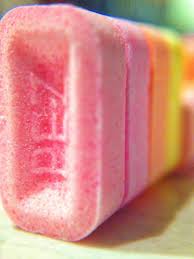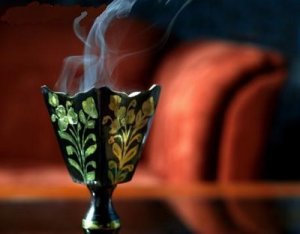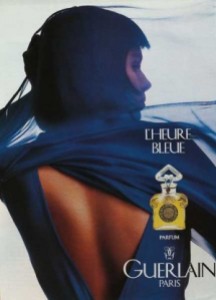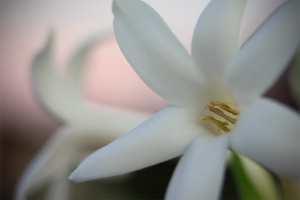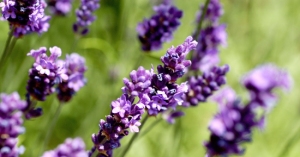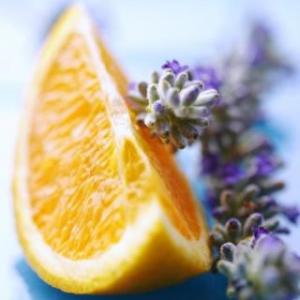Last week was Persian New Year, so I thought it was an apt time in my series on DSH Perfumes to cover the brand’s two Persian-inspired fragrances. The first one is Nourouz, which means “New Year” and which is specifically intended to celebrate the March holiday. The second is Ruba’iyat which Dawn Spencer Hurwitz says was inspired “by the Persian poetry form of the same name, and traditional oudh designs of the region.”
NOUROUZ:
Nourouz is a natural eau de parfum that also sometimes goes by the name Tamarind/Paprika. The DSH website provides the following description:
A rich, round, smoky-incense nuanced perfume within a classic fruity-chypre design style.
Nourouz, the name for the New Year celebration traditional in Persia, is as exotic as it’s name. Based on luscious tamarind and sensual paprika, this is a perfume that smolders and sizzles.
The notes, as compiled from Fragrantica and the tags on DSH Perfume, are:
Top notes: Black Pomegranate (accord), Paprika, Tamarind
Middle notes: Bulgarian Rose Otto, Orris, Osmanthus, East Indian Patchouli.
Base notes: Oppopanax, Red Wine notes, Tobacco Absolute, Vanilla Absolute.
Nourouz opened on my skin with pomegranate and tart, tangy, tamarind molasses, all dusted with dry, somewhat dusty paprika. A lovely, dark, wine accord runs through it, smelling almost like a cherry cordial, but without the latter’s extreme sweetness. A glimmer of vanilla darts in between the various tangy notes which are really lovely in their originality.
Nourouz’s opening recreates the sense of original ingredients very well. When I was in India, I loved to eat packaged tamarind that was partially a type of solid molasses that was stuck together with lumps of the whole pods, all infused with salt. And I love pomegranate juice in general, so it is a lovely surprise to see how well that aroma is captured here. I’m less enthused by the fact that Nourouz opens as a really intimate scent that hovers just barely above the skin, regardless of how much I apply.
Nourouz shifts quite quickly on my skin. A delicate, very pale, pink rose creeps onto the scene after 10 minutes. The perfume also turns into a complete skin scent at this point which makes it harder to detect its nuances. For the most part, Nourouz’s opening bouquet smells primarily of very tart, tangy, dark fruits with a cherry-tamarind aroma, lightly flecked by a pale rose and a drop of vanilla. Then, five minutes later, the osmanthus arrives, smelling of apricots with the faintest undercurrent of black tea and leather. At first, it is a mere flicker but the osmanthus soon grows increasingly prominent, overshadowing the tamarind, wine, and even pomegranate accords.
What was interesting to me was what happened when I applied a double dose of Nourouz. Then, the fragrance opened with the osmanthus, followed by hints of tobacco absolute and smokiness. The latter both faded away quickly, replaced by the pomegranate and tamarind notes. The wine was very muted, as was the paprika on my skin, and there was virtually no rose at all. Instead, there was the tiniest hint of something powdery, presumably from the iris/orris accord. Yet, even with the higher quantity, Nourouz still turned into a skin scent after 10 minutes. It was simply much more concentrated when smelled up close.
Regardless of quantity or test, Nourouz soon ends up in the same place on my skin: an osmanthus-dominated fragrance with tea, followed by dark fruits and the occasional whisper of smokiness. After 45 minutes, it is a wisp of osmanthus and tea with vaguely fruited nuances and a touch of abstract dryness. There is the occasional suggestion of something lightly soapy that appears deep in the base, but it is muted. Nourouz fades away shortly thereafter as a blur of abstract fruity florals. The perfume lasted 1.5 hours with the amount I usually apply in perfume testing (2 large smears or the equivalent of 1 spray of perfume), and 2 hours with double that quantity.
On Fragrantica, there are 4 reviews for Nourouz, two of which are quite positive. One person, “Sherapop,” writes:
This perfume goes through three very distinct stages on my skin and for my nose. It opens like Christmastime with lots of spices and the feeling of a fir tree or maybe potpourri? Either way, it’s very festive feeling. Then the scent suddenly smells for a brief period like a rubbery leather. I have no idea what could account for it, but that’s what I smell (and I’ve worn it a couple of different times).
By the drydown, DSH Nourouz has become a beautiful rich oriental with a touch of sweetness and something indescribable which might be the tamarind? What a ride! Very interesting.
Another commentator thought that Nourouz was “most delicious with sweet, dark seduction”:
Initially tamarind is present with a little tartness to complement the dark pomegranate perfectly. Paprika isn’t too spicy but rather delivers an earthy depth.
I love osmanthus as its warm, apricot-like floral scent is perfectly paired with the soft, smoky tobacco. Rose and orris further soften the composition creating a feminine allure.
Opoponax is one of my favorite notes and combines well with vanilla and red wine accord to tantalize the senses without being overwhelming.
Nourouz has made it to one of my most favorite DSH fragrances. Well blended and elegantly delicious all the way.
The other two posters were not as excited. One commentator, “Doc Elly” (or Dr. Ellen Covey of Olympic Orchard perfumes) specifically mentioned Nourouz’s longevity which was only an hour on her skin:
This one is a little disappointing, not because of the scent itself, but because it seems weak. It’s basically a subtle rose-violet scent with a few unidentifiable notes modifying it. After testing it and finding that it faded in an hour, I looked up the description on the DSH website, where it lists the base notes as things like opoponax and red wine. These seem more like top or mid notes rather than base notes, so it’s not too surprising that there’s no longevity. The scent is nice, but a little too delicate and fleeting for my taste. I’ll pass on this one.
I’m afraid the sillage and longevity are an issue for me as well.
RUBA’IYAT:
Ruba’iyat is a natural, 100% botanical eau de parfum that is based “on a traditional, middle eastern style Oudh oriental scent.” The DSH website adds the following:
Inspired by the Persian poetry form of the same name, and traditional oudh designs of the region. Created for indiescents.com, Ruba’iyat is a glorious all botanical middle eastern oudh, incense, saffron, and spice perfume.
The notes, as compiled from a comment on Fragrantica and the general tags on DSH Perfume, include:
Galbanum, Spicy notes, Davana, Gallic Rose Otto, Rosa centifolia, Saffron, Myrtle, Geranium, Indian Sandalwood, Oud, Frankincense CO2 absolute, Myrrh, Patchouli, Labdanum, Cumin, and Ambrette CO2.
Ruba’iyat opens on my skin with a potent blast of galbanum that is sharp, green-black in visual hue, and verging on the leathered. It is imbued by an equally sharp tobacco note, and a very skanky element that is almost civet-like, in addition to being a little sweaty. It clearly seems to stem from the combination of ambrette and cumin.
Seconds later, the davana arrives on the scene, smelling intensely of apricot fruitiness. In its trail are rose, more cumin, smoky incense, and a dark note that feels like very dark, rather tobacco-like leatheriness. I suspect the latter stems from the oud mentioned in Ruba’iyat’s description, but I really don’t smell agarwood in the way that I’m used to. Instead, it comes across primarily as a sort of leathered tobacco on my skin.
The overall effect is interesting with a profile that is incredibly pungent, sharp, leathered, green-black, fruity, smoky, and animalic, all at once. There is an intense, dirty, sweaty undertone that clashes with the fierce galbanum and the intense fruitiness of the davana. Rose swirls all around, feeling sticky and jammy, while incense seeps out from every corner. Despite the latter, I keep thinking of how Ruba’iyat’s very dominant galbanum element evokes memories of Robert Piguet‘s Bandit, only in a very fruited, apricot embrace that is dusted with cumin and skank. In the background, there are flickers of fuzzy, peppered, piquant geranium leaves that feel a little bitter and that add to the green-black visuals.
Less than 10 minutes Ruba’iyat’s development, the perfume starts to shift. The saffron rises up from the base, smelling sweet, lightly fiery, and with a bite that is almost like chili pepper at first. It wraps itself around the rose and davana in a way that is really pretty, especially once the galbanum mellows out. As its pungent bite fades, only the strong veil of “leather” (oud?) remains. It is skanky, smoky, and covered with treacly, resinous labdanum. Spices lurk at the edges, particularly a clove-like note. There is also the faintest suggestion of a wine or cordial-like undertone, as if the rose and patchouli had combined with the dark leather and spices to create a deep, Italian Amarone wine impression.
Ruba’iyat seems to mix masculine and feminine traits in a very clever way. I have competing visuals of, on the one hand, blood-red liqueur that borders on the black with tobacco, pungency, skank and sharp smoke, but, on the other, feminine, juicy apricot florals nestled amidst geranium green leaves and sprinkled with gold-red saffron. The cumin retreats to the background after 15 minutes, but the ambrette continues its animalic skank in a way that is reminiscent of the sharp opening of Serge Lutens‘ Muscs Koublai Khan. I don’t mind it but some other parts of Ruba’iyat are a little too pungent and sharp for me.
At the end of the first hour, Ruba’iyat is a pretty, fruity floriental centered around juicy apricot, leather and tobacco, followed by sharp incense, warm amber, patchouli, rose and animalic musk. The pulpy apricot is potent, concentrated, and deep, but it also starts to take on a peach undertone as well. The whole thing wafts a mere inch, at best, above the skin.
Ruba’iyat remains largely unchanged for the next few hours, with the main difference being the order and prominence of some of its notes. The rose becomes more significant after 90 minutes and starts to resemble the rose-water syrup used in a number of Middle Eastern pastries. It even retains the same sort of light saffron dusting. At the end of the 3rd hour, Ruba’iyat is a jammy apricot rose with “tobacco,” sharp incense, musk, a dash of saffron, and a very leathery, dark undertone. Eventually, the perfume turns into a simple fruited floral with darkness and a musky, earthy tobacco note. Sometimes, the rose is more individually distinguishable, but usually it is the apricot-peach impression. In its final moments, Ruba’iyat is a blur of fruitiness with dark earthiness.
I gave Ruba’iyat two full tests, using different quantities. When I used 2 large smears or the equivalent of 1 spray from a bottle, Ruba’iyat lasted just under 6 hours. With a double dose, however, Ruba’iyat lasted 8.5 hours. In all cases, the perfume was very concentrated and strong in feel, but the sillage hovered just above the skin at first. Ruba’iyat only turned into a skin scent with the higher dose at the end of 2 hours, but it was very easy to detect up close for hours on end.
There are two reviews for Ruba’iyat on Fragrantica. The first one is from a chap who adores the scent, despite being less than enthused about cumin (or oud):
Oh my. Cupid has finally found a DSH arrow with my name on it and I am overcome with love. This has one of my least favorite notes (cumin) and my observation has been that there’s an oudh meme with most niche perfumers right now whether it makes sense or not(oudh and spaghetti! Yes!) so I had few expectations. Instead I find a lush rich bazaar of notes that are warm, spicy and beautifully layered. This may be the best saffron scent I’ve experienced to date. Spices and resins predominate and even after wearing this several times for hours it’s difficult to pick out individual notes but this stuff is wonderful. This perfume has enough personality that I’d strongly recommend a sample before a bottle–your feelings about this will not be lukewarm.
Sillage: reasonable, 1-2 ft
Longevity: several hours
Fabulosity: the 1,001 nights
Value to price ratio: very good
9/10
The second review comes from “Sherapop” and is not as positive, primarily because of the cumin:
DSH Ruba’iyat is a very complex oriental perfume, with a lot of potent players vying for attention. […][¶] What to say about this concoction? I find it rather kaleidoscopic, with wafts of this and that popping up and then fading out as they are bumped off by other equally strong scents. I detect the saffron, cumin, and davana the most. Since cumin and davana are not my favorite notes (to put it mildly), this is not my favorite perfume from DSH.
I imagine that guys who enjoy cumin-centric fragrances might like this composition a lot. Definitely a try-before-you-buy is in order.
I agree with her. This is a scent that you should test, especially if you are undecided on the issue of cumin. For me, personally, my difficulty stemmed not from the cumin, but from the mix of somewhat strange, brown, tobacco-y earthiness infused with sharp pungency and muskiness. The apricot, however, was very nice.
At the end of the day, neither fragrance suits my personal tastes or style, but they are both interesting and feel very original. If you’re a fan of osmanthus or tamarind, you may want to consider Nourouz. By the same token, if apricot is your thing, and you would like to see it paired with animalic skankiness, dark notes, oud, and incense, then you may want to consider Ruba’iyat.
Disclosure: Perfume samples were courtesy of DSH Perfumes. That did not impact this review, I do not do paid reviews, and my opinions are my own.






















